The actuator, or solenoid, is a device that electrically generates magnetic fields to control the armature for ideal torque and displacement. The armature is a ferromagnetic substance, which generates suction and converts electrical energy into mechanical energy when subjected to magnetic field, and is used to control the speed, direction, displacement and force of load.
Actuator, sometimes also known as brake, solenoid valve, electromagnet, etc., has a wide range of applications, such as fuel injector (solenoid valve of oil valve), power distributor (cut-out device, circuit breaker, relay, contactor, etc.), various automobile, hydraulic industrial applications, etc.
The company provides multi-level physical integrated design solutions for electromagnetism, structure, fluid and control to meet the design requirements of actuator such as electromagnetic analysis, performance optimization, temperature rise and deformation, structural stress analysis, and control system integration, so as to comprehensively solve the design problems of actuator.

There are many structures of actuators, but the working principle is basically the same. The typical electromagnetic actuator includes a multiturn coil wound on the plate and a movable armature. In addition, the core of the casing frame provides a closed loop for flux, and figure 2 shows the geometry of the frame, magnetic pole piece, coil and armature.

When the electromagnetic actuator is connected with the voltage source, the current in the coil is passed and the magnetic flux is generated, and the armature is driven from the open position to the closed position. Some electromagnetic actuators can use a permanent magnet, assisting it in building the magnetic flux or helping the armature stay in a certain position when the coil voltage is turned off. For example, the voice coil actuator uses a permanent magnet to generate the magnetic flux and coil current interaction, thus generating lorentz force in the coil. These devices may be two-dimensional or three-dimensional structures, and the moving parts may be rotating or non-circular (such as swinging of a joystick).
The armature, plate and frame of the actuator are all ferromagnetic materials. The shape and size of the armature and the matching with the magnetic plate will affect the force index of the actuator at the closing time. In addition, the coil design determines its resistance and inductance, especially inductance, as it is proportional to the square of coil turns times the total reluctance of the nonlinear ferromagnetic material and air gap. The ratio of L/R is the normal electrical time of the device, which determines the speed of current rise in the coil, while the speed of magnetic field establishment in the device depends on the electric eddy current, so the electromagnetic diffusion time also affects the performance of the actuator.
During the rapid rise of the coil current, the magnetic flux diffuses to the entire magnetic circuit of the actuator, and is concentrated on the inner surface of the actuator. This will delay the setting up time of the electromagnetic force of the armature, thus delaying the closing time. Similarly, when the applied voltage source is switched off and the magnetic field is withdrawn from the device, the reopening time of the actuator armature will be delayed due to the presence of residual magnetism. As time goes on, the magnetic field passes through the thick wall of the equipment, and the stress on the armature increases. Therefore, the magnetic pole shape, material and coil design will directly affect the magnetic diffusion process, and further affect the closing time of actuator. Maxwell transient field solver can analyze the diffusion process of local magnetic field after the eddy current.
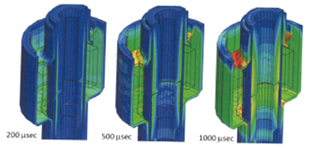
Maxwell's static or transient solvers enable two-dimensional and three-dimensional electromagnetic field analysis of actuators. Generally, parameters such as coil shape, turns, line diameter and geometric size are set as parameterized/optimized variables in static simulation, and a set of curves reflecting force and position is output by changing coil current and armature position. Since Maxwell began to used automatic adaptive mesh generation, it is very easy to parameterize/optimize the scan of variables.
In addition to the static method, Maxwell transient solver can be used to simulate the speed problem of the armature when reaching the closed position, considering the electrical control and mechanical load conditions. For example, the external excitation voltage source is an arbitrary waveform (or using the circuit editor tool provided by Maxwell), while the non-linearity of materials, the motion equation of machinery (including damping, load bearing, and all of them can be a function of position, velocity, or time), and the eddy current and magnetic diffusion are considered.

Most actuators adopt soft magnetic materials as magnetic path.Because the BH loop of soft magnetic material is narrow and the coercivity is small, the initial magnetization curve is usually used to calculate the BH operating point. However, when the coil of the actuator is cut off, the magnetic field will not fall to 0 and there will be residual magnetism, which will directly affect the electromagnetism and closing time calculation of the actuator. Maxwell can truly consider the characteristics of soft magnetic materials of actuators through the modeling function of vector hysteresis materials, and accurately analyze the residual magnetism effect of soft armor materials, so as to accurately calculate the transient electromagnetic characteristics of actuators such as magnetic field diffusion, electromagnetic force and closure time.

The coil and core losses obtained by Maxwell's transient electromagnetic field simulation analysis can be mapped to Mechanical or CFD (computational fluid dynamics) software, Fluent, for thermal analysis by ANSYS WB environment, as shown in figure 8. Its coupling mode including: Electromagnetic field analysis for the total loss of spatial distribution of thermal model is mapped to a Fluent, through accurate considering complex thermal environment, including convection and heat transfer, direct calculation of temperature rise and the temperature of components of data back to the temperature of the modified material in Maxwell's attribute and to recalculate the loss, so two-way coupling iterative, get actuator coil and iron core components such as steady-state temperature;In Mechanical temperature field calculation using simple Settings, namely direct definition of coefficient of heat transfer, or the heat transfer coefficient calculated by the Fluent software, and then through the electromagnetic - thermal transient thermal performance and thermal cycle analysis after the iteration times get steady temperature of the actuator, the process of the simulation calculation speed than the direct calculation of temperature rise fast in the Fluent software, and the simulation precision is greatly improved.

The eccentricity of actuator during assembly will affect the performance of actuator. If the armature moves off the center, it will lead to lateral electromagnetic force and cause excessive friction on the bearing surface. At the same time, eccentricity may be overall eccentricity, or axial eccentricity, or axial tilt. ANSYS Maxwell can display the force density distribution at any position and current density by means of cloud or vector diagram.
The structural strength of actuator and the performance of its natural frequency system also have a great impact when the actuator starts working condition and working condition of the maximum travel. ANSYS Workbench can also accurately analyze the structural strength and natural frequency of actuator under different working condition.

The actuator design should take not only its electromagnetic and multi-physical domain coupling characteristics, but also its power supply and control circuit integration into considerations. Simplorer can realize the design of behavior-level actuating system and quickly analyze its performance. The design of high-precision physical prototype-level actuation system can also be realized by cooperating with Maxwell simulation (taking into account the nonlinear effect of materials, eddy current and magnetic diffusion, etc.), or through the interface of the reduced price model (considering only the position of actuator and current parameterized scanning relation, and ignoring the eddy current effect of coil), so as to accurately analyze its performance. The multilevel modeling function of Simplorer platform is shown in figure 9, and the high-precision actuation system design model of Simplorer platform is shown in figure 10, including equipment-level power electronics devices, closed-loop control systems, accurate two-dimensional or three-dimensional actuator models, and mechanical or hydraulic loads. The driving circuit and Maxwell finite element model transient link are used for collaborative simulation. The mechanical pin is directly connected to a device defining weight, force, spring and stop limit.
The design solution of ANSYS actuator not only provides finite element analysis and optimization design tools for electromagnetic field, but also can realize static and transient magnetic field analysis and performance optimization of actuator. It also provides static thermal and transient fluid thermal analysis tools, which can realize electromagnetic and thermal bidirectional coupling analysis. And it also provides the circuit and system design tools, so as to achieve higher level from behavior to physical prototype, to get the multi-level and high precision system design, which can help users efficiently realize the seamless multi-physical domain integration design process of actuator. Because of high precision simulation, we could minimize production prototype, shorten the development cycle, and lower development costs, which is conducive to the user among the fierce competitors.

As the new energy vehicle market in China has continued to expand, power batteries, as the "heart" of new energy vehicles, are facing a big challenge. Since 2013, China has witnessed rapid development of new energy vehicles. By 2017, the number of new energy vehicles in China has reached over 1.6 million, making China the world's largest new energy vehicle market. The Power battery, as a key component, which related technology must be adapted to the development of electric vehicle. How far the new energy vehicles can greach depends ultimately on how far the power batteries can go. Based on the technological advantages and development trends of various kinds of batteries, lithium ion batteries will be more and more widely used in hybrid electric vehicles, plug-in hybrid electric vehicles and pure electric vehicles. This kind of power battery technology is of great significance to the development of new energy automobile industry.
At present, there are over one hundred enterprises producing power batteries in China. However, due to the low degree of automation, many enterprises are characterized by low production efficiency, low qualified product rate and low efficiency of operation information interconnection. This problem makes it difficult to make substantial breakthroughs in terms of technology and consistency, which seriously affects the overall performance of power batteries and restricts the development of new energy automobile industry in China.
Based on such condition, the intelligent manufacturing of power battery came into being. In the future, the manufacturing of new energy vehicles, including power batteries, is bound to be large-scale and intelligent, featuring high precision, high speed and high reliability. Meanwhile, simulation, as an important part, will play a vital role.
Mechanical performance analysis of new energy power battery includes: strength analysis, modal analysis, PSD random vibration analysis, collision analysis, extrusion analysis, drop analysis, impact analysis, fatigue analysis, etc.
New energy power battery thermal (thermal management system) performance analysis includes: battery pack’s low-temperature charging thermal analysis, and natural cooling CFD analysis.
Electrical system simulation of new energy power battery: circuit simulation, charge-discharge process analysis, etc.
3.1 The strength and stiffness of the power battery pack

3.2 The vibration of the power battery pack

3.3 The display dynamics of the power battery

3.4 Battery fatigue

3.5 Heating and heat dissipation of the power battery

3D model import: ANSYS is specialized in the imported model, no matter the parts or the assembly. The model can be imported either through intermediate format file, or directly by the corresponding interface (interface module) into the 3D model software, which can realize real-time two-way transconductance model, and implementation model information condition, to keep the original parametric data, for the subsequent optimization design.
Modeling and model repair: ANSYS's SpaceClaim software, based on the idea of direct modeling, is more convenient to establish three-dimensional solid model or finite element model (beam element extraction, intermediate surface, internal and external fluid, spot welding, etc.), as well as model repair (chamfer removal, filling, interference surface, etc.) and other operations, and the interface is operated more easily for users.
Convenient operation interface: The analysis process of ANSYS is unified and integrated in the workbench platform. The clarity and logicality of process are strong. Various analysis types (such as structural stress analysis, modal analysis, random vibration analysis and fatigue analysis) are unified and carried out in the workbench platform, so the data conversion is very convenient.
Meshing: For mesh types, ANSYS has one dimensional mesh, two dimensional mesh (triangular/quadrilateral), and three dimensional mesh (tetrahedral/hexahedral/wedge). And the grid control methods are similar, including topology optimization, damage tolerance, expansion layer, high quality shell grid, etc. ANSYS is very skillful in grid control. Besides ANSYS meshing, ANSYS ICEM CFD, another powerful grid software, is added.
Multi-physical field coupling: The Workbench platform of ANSYS combining several items into a single form, which are structure, electromagnetic and fluid analysis, and it’s absolutely perfect operating platform for multi-physical field coupling.
Geometric modeling:ANSYS SCDM
Structural simulation analysis: ANSYS Mechanical Enterprise
Fatigue life analysis:ANSYS nCode Designlife
Fluid simulation analysis: ANSYS Meshing、ICEM CFD、ANSYS Fluent/CFX
Acceleration Module:ANSYS HPC
The new energy vehicle industry in China started in the early 21st century. In 2001, the research project of new energy vehicle was listed among the 863 major science and technology issues in the fifteenth issue of the state publishing. And the strategy of starting with gasoline vehicles, like hydrogen cars, was planned as well. Since the 11th five-year plan, China has developed a series of strategies of energy saving and new energy vehicles. The government has paid great attention to the research and development and industrialization of new energy vehicles.
Under the pressure of energy and environmental protection, new energy vehicles will undoubtedly become the developmental direction of future automobiles. During the period of the 12th five-year plan , Chinese new energy vehicles will officially enter the industrialization development stage: from 2011 to 2015, it’s the industrialization stage. The new energy city buses, hybrids and small electric vehicles has been promoted in the whole society. During the period of the 13th five-year plan (2016-2020), China will further develop new energy vehicles, during which multi-energy hybrid vehicles, plug-in electric vehicles and hydrogen fuel cell vehicles will gradually enter into ordinary households.
At present, the application of new energy vehicles domestically and abroad has been developing continuously and the research and development has been deepened constantly. Key parts and systems of electric drive such as drive motor, power battery system, IGBT and controller have always been the hot spots, focuses and difficulties in the research of new energy vehicles. Compared with the advanced level of foreign countries, the research on new energy vehicles in China still has a big gap in these aspects. The design and virtual simulation of new energy vehicle are very challenging, which needs to be practiced continuously.
New energy vehicle system is relatively complex, and the design process involves multiple fields, including electromagnetics, control system, power electronics, electro-machinical, fluid dynamics, thermal, embedded software and other different fields, as shown in figure 1. It involves several design departments, including design assembly department, motor body department, control system department, battery design department, mechanical design department, etc. The interdisciplinary design of the whole new energy vehicle increases the difficulty of the design. Different departments have different concerns and different levels of requirements. In conclusion, how to consider the performance of each key point comprehensively, how to design the complex new energy vehicle system comprehensively, how to coordinate the design, and how to solve the design problems of multiple-domain physical are all complex tasks.
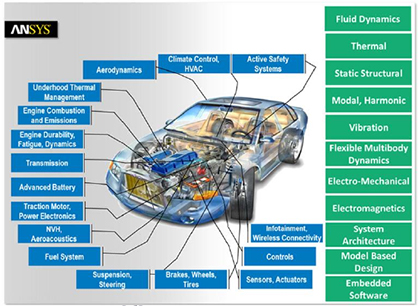
Compared with traditional cars, new energy vehicles have stricter design indicators. At present, the power battery system of new energy vehicles severely limits the driving distance. To overcome this difficulty, the reduction of the weight of each part as much as possible should be taken into considerations when designing the new energy vehicles, in order to reduce the volume and improve the efficiency.
For the convenience, reliability and comfort of new energy vehicles, accurate design of radio transmission system, battery pack modeling and thermal management system, motor and motor control system is required. At the same time, the number of electronic devices inside the new energy vehicles has been greatly increased. In the process of redesign, the problem of mutual interference between various electronic devices in cars, namely EMI/EMC problem, and the problem of heat dissipation and vibration of electronic devices should be fully considered.
Similar to other advanced system design processes, the design process of new energy vehicles is conducted step by step from the conceptual design, the system design, to the subsystem design and component design. During the validation phase, integration and validation are required from the order of components, subsystems, and systems. In order to save developmental time and design cost, this design and verification process of new energy vehicles will not adopt all real physical prototype design and testing, but adopt some real or all virtual level design and verification, namely virtual design and virtual testing.
In the process of virtual design and virtual testing, different departments have different requirements on the model level. More behavioral models will be used at the overall design level, and more accurate physical models will be used at the component design level. From the physical model to the behavioral model used in the system simulation, the simulation platform needs to adopt better model reduction and cooperative simulation technology.
In the process of the component design in the new energy vehicles, it is often necessary to consider not only the performance in a single physical field, but also the comprehensive performance of multiple-region physical, such as electromagnetism, structure, ventilation and heat dissipation, so the design of a platform is required to meet this design requirement.
The new energy vehicle is a complex product composed of thousands of parts. In the process of simulation design and development, it involves complex problems in multiple physical fields such as fluid, structure, temperature, electromagnetic and control. At present, ANSYS simulation technology is widely used in the design of new energy vehicles, as shown in figure 2:

In view of the strict design indicators of new energy vehicles and the complexity of system design, its complex systems and products require solutions to cover all physical fields and subject areas. ANSYS has provided with an overall digital virtual design solution including system design and multi-physical domain design.
The integration platform in the ANSYS system is dedicated to the performance prediction and analysis of systems and subsystems in electromechanical systems. It not only realizes the multi-level digital design from component to system, but also makes the system and components closely connected from the initial plan to the final plan, thus making the design process more reasonable. The ANSYS integrated simulation platform in multiple physical domains can comprehensively consider the electrical, electromagnetic, thermal, structural, fluid and other thermal properties of the whole system and its components. The design of a typical electric vehicle driving system is shown in figure 3.
EMI/EMC design is a special problem in mechanical and electrical system performance analysis. Based on circuit analysis tool and the electromagnetic field analysis tools, the sub-system of EMI/EMC in the integration platform interconnect and share the link of data. From the point of view of frequency domain and time domain, it realizes the PCB conduction and radiation disturbance control and electromagnetic compatibility design, chassis cabinets shielding effectiveness design, and the typical EMI/EMC analysis of systems and circuit simulation, combined with the PCB, wire harness, nonlinear digital components, analog parts and radio frequency devices.
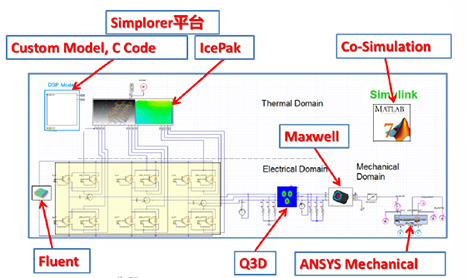
Simulation of basic physical system is the basic tool of modern electromechanical system design, and also the cornerstone of the multi-physics domain research and development platform of all digital electromechanical system. The basic physics simulation system is used to solve all the key problems involved in the development of new energy vehicles, including structural analysis problems, ventilation and heat dissipation problems, electromagnetic analysis problems, vibration and noise problems, motor control problems and EMI/EMC problems. From the perspective of robust design, the basic physical simulation system also includes multi-objective optimization, sensitivity and reliability analysis, and statistical analysis. Through the integration with the aforementioned basic physical simulation system, the stability design would be carried out.
ANSYS multi-physics domain simulation solutions include electromagnetic analysis, structural analysis, vibration analysis, fatigue analysis, noise analysis, fluid analysis, thermal analysis, multi-objective optimization analysis, etc.
Multi-physics domain collaborative optimization platform is a basic platform for the accurate design and optimization of the underlying components of electromechanical systems. The collaborative design is a complicated physical problems, restraining and influencing one another. This kind of complex synergy with fundamental physics can meet the precision analysis of a single physical domain, and the collaborative optimization platform integrates these different physical domain analysis systems and tools to realize data sharing, functional interconnection between different physical field tools and form a unified design environment with similar operations. The analysis systems and tools in these different physical domains can carry out real multi-physical system analysis of individual components within the platform at the same time, and integrate multi-physical mutual constraints into the consideration of the development of virtual prototype. As a result, the virtual prototype is more realistic, as shown in figure 4:

With the development of science and technology and the improvement of people's living standards, elevator, as an indispensable and important equipment in high-rise buildings and public places, has been widely used. After more than 100 years of development, there is a high degree of industry concentration in the global elevator industry. Otis, Mitsubishi, Kone, Schindler and some other brands have gradually become well-known brands of global elevators and occupy a large share of the global market. Due to the imbalance of social and economic development, there exists huge difference among the global elevator markets. The elevator industry in developed countries such as Europe, America and Japan started earlier. At present, the number of elevators has reached about one for every 200 people. However, due to the slow growth of population in recent years, the number of elevators is basically stable. In China, Southeast Asia, the Middle East and other countries and regions, the elevator industry started late and has a relatively low per capita elevator amount. However, in recent years, their economy has been growing rapidly. Infrastructure construction has been vigorously developed, and the demand on elevator has been growing rapidly as well, in which these countries have become an important new elevator consumption market in the world.
In the 21st century, the technical and management level of a group of national elevator enterprises have increased significantly, including Canny Elevator, SJEC, Yuanda Intellectual, IFE Elevator and several national elevator enterprises with considerable scale. These enterprises have quickly improved the development, design, manufacture, installation and maintenance of the elevator, to complete the business chain construction, especially in the low speed elevator products. With the higher ratio of performance to price, the foreign brand monopoly has gradually been broke in the Chinese elevator market.
Mechanical performance analysis of elevator structure, including strength and stiffness analysis, modal analysis, PSD random vibration analysis, drop analysis, impact analysis, fatigue analysis, etc.
Hydraulic performance analysis of elevator, including Thermal analysis of control cabinet and frequency converter, high speed aerodynamic analysis, etc.
Elevator control system simulation: circuit simulation of the system, EMC/EMI analysis of the main control board, etc.
3.1 The strength, stiffness and vibration of the elevator

3.2 Heat Dissipation of Elevator

3D model import: ANSYS is specialized in the imported model, no matter the parts or the assembly. The model can be imported either through intermediate format file, or directly by the corresponding interface (interface module) into the 3D model software, which can realize real-time two-way transconductance model, and implementation model information condition, to keep the original parametric data, for the subsequent optimization design.
Modeling and model repair: ANSYS's SpaceClaim software, based on the idea of direct modeling, is more convenient to establish three-dimensional solid model or finite element model (beam element extraction, intermediate surface, internal and external fluid, spot welding, etc.), as well as model repair (chamfer removal, filling, interference surface, etc.) and other operations, and the interface is operated more easily for users.
Convenient operation interface: The analysis process of ANSYS is unified and integrated in the workbench platform. The clarity and logicality of process are strong. Various analysis types (such as structural stress analysis, modal analysis, random vibration analysis and fatigue analysis) are unified and carried out in the workbench platform, so the data conversion is very convenient.
Meshing: For mesh types, ANSYS has one dimensional mesh, two dimensional mesh (triangular/quadrilateral), and three dimensional mesh (tetrahedral/hexahedral/wedge). And the grid control methods are similar, including topology optimization, damage tolerance, expansion layer, high quality shell grid, etc. ANSYS is very skillful in grid control. Besides ANSYS meshing, ANSYS ICEM CFD, another powerful grid software, is added.
Multi-physical field coupling: The Workbench platform of ANSYS combining several items into a single form, which are structure, electromagnetic and fluid analysis, and it’s absolutely perfect operating platform for multi-physical field coupling.
Geometric modeling:ANSYS SCDM
Structural simulation analysis: ANSYS Mechanical Enterprise
Fatigue life analysis:ANSYS nCode Designlife
Fluid simulation analysis: ANSYS Meshing、ICEM CFD、ANSYS Fluent/CFX
Acceleration Module:ANSYS HPC
Electromotor is one of the most widely-used energy conversion device, divided into two categories:generator and motor according to the energy conversion mode. The electromotor system is a complex system integrating electric, machinery, dynamic, heat dissipation, electronic circuit, control system and other disciplines.
The design of new energy electromotor is a complex multi-field physical problem, which involves many fields such as electromagnetism, structure, fluid, temperature and control.With the development of new materials, new technologies and various new electromotor technologies, the requirements of electromotor design have become more and more demanding, especially for the requirement about precision. Thus, traditional design methods and means can no longer meet the requirements of modern electromotor design. It is essentially necessary to depend on modern simulation technology to solve various design problems.
On account of the development trend of permanent magnetization, high speed, brushless electronic and digitization, integration, intelligence, high efficiency and energy saving,and other related technology challenges, ANSYS can provide with integrated design solutions and processes, in order to efficiently produce the advanced electromotor in the magnetic circuit method and the finite element, the parts and the system, the electromagnetic and multi-field, multi-level, and integrated electromotor and in the drive or control system design.
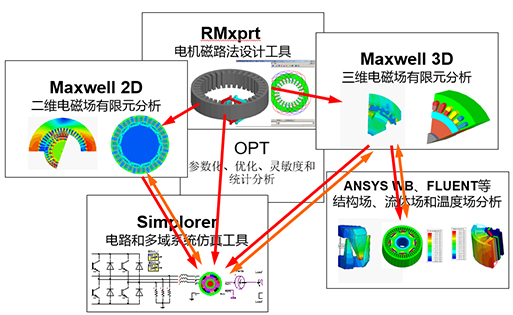
According to RMxprt, the design specialists in the electric rotating machinery based on magnetic circuit method, it’s not only possible to finish as many as 19 kinds of calculation through motor magnetic circuit method, but to instantly generate both the double-dimensional and three-dimensional parametric finite element modelings in one time, including setting up geometric model automatically, the material properties, gridding plot, boundary conditions, external circuit, movement and solutions, and so on. Moreover, a set of variables in the RMxprt’s modeling can seamlessly be transferred to Maxwell, which is better for parameterization, optimization, simplification of process in the finite element analysis of electromagnetic field and transient performance optimization.

Based on Maxwell 2D/3D, the finite element analysis software of electromagnetic field, just simple modification of RMxprt finite element model can directly lead to accomplishment of all motor electromagnetic performance analysis of normal and fault conditions, such as: the cogging torque, Open circuit counter emf, Rated load, torque current, winding short circuit/open circuit, conducting bar fracture, and so on. Besides, it can be directly set or activate a set of RMxprt variables, to parameterize/optimize all kinds of transient characteristics of the motor design. By means of HPC and DSO, the motor electromagnetic calculation and performance optimization process can also be accelerated. Combined with internal and external circuit or Simplorer circuit, after simulating and optimizing the fem model of the motor, the equivalent circuit model is output for backup.

Simplorer was used to simulate the motor and control system. Using SCADE suite, the embedded control code was generated automatically.Combined with Maxwell field coupling, transient collaborative simulation technology, the extraction technology of parasitic parameters of Q3D cable, busbar and IGBT, high precision simulation and performance optimization are carried out for the whole electric drive system.

With Maxwell outputting the geometric model of motor and distributed loss, the temperature field simulation of the motor is carried out through Mechanical/FLUENT and other tools, implementing electromagnetic and thermal single/two-way coupling analysis, in order to predict the temperature rise of the motor under various working conditions, in which the cooling system design can be optimized.

With the geometric model of motor outputted by Maxwell, the automatic coupling simulation process of electromagnetic, vibration and noise realized by Workbench and ANSYS, structural stress, deformation and vibration noise of motor under various working conditions can be conveniently analyzed.
In addition, ANSYS also provides customized development functions UDO and ToolKit to facilitate users to streamline and automate complex design. UDO can directly output various electromagnetic performance data of the motor after the finite element analysis of the electromagnetic field. 0ToolKit can instantly complete and output LdLq of permanent magnet and induction motor, efficiency Map, torque speed curve of motor, etc. Meanwhile, with the help of MPTA control algorithm, the influence of temperature, frequency variation alternating resistance, inclined groove and iron loss coefficient at different frequencies on motor performance would be fully taken into our consideration.

UDO is a post-processing tool built in Maxwell for motor design. It can directly output the input and output power, torque, speed, various losses, LdLq, efficiency, power factor and other electromagnetic performance data of the motor after the finite element calculation of electromagnetic field.
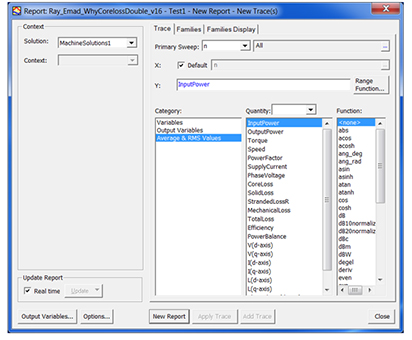
Toolkit is a custom post-processing tools built in Maxwell for motor design. It can instantly complete and output the efficiency Map graph, the loss Map graph, LdLq and current Map graph, and the torque speed curve of the permanent magnet motor. Depend on the MPTA control algorithm of maximum torque output per unit current, the temperature, frequency variable ac resistance, chute, iron loss factor at different frequencies are all considered.
